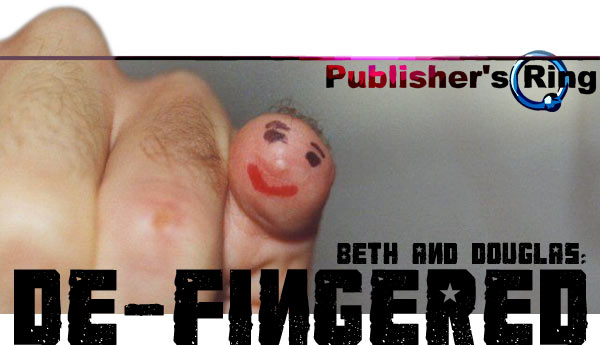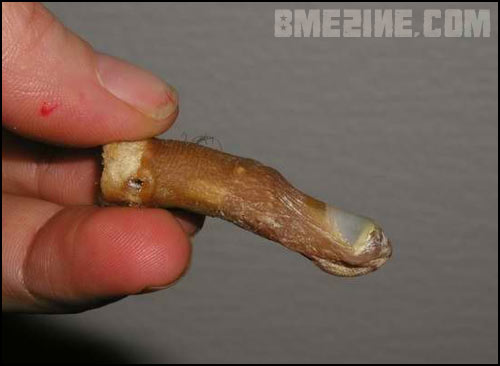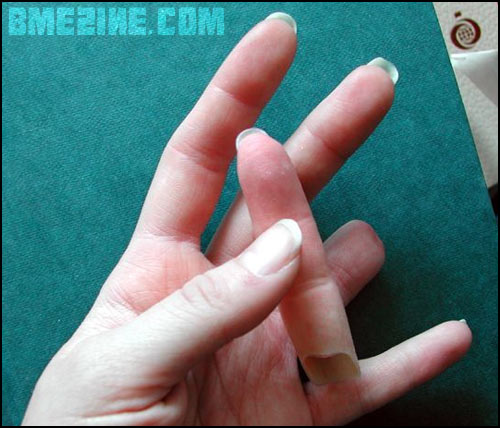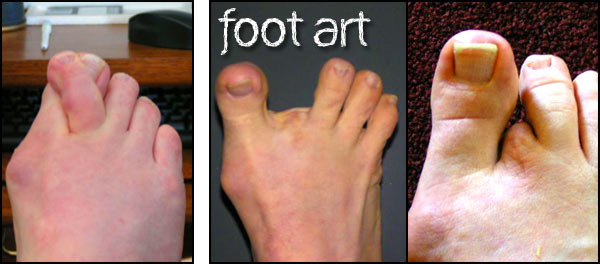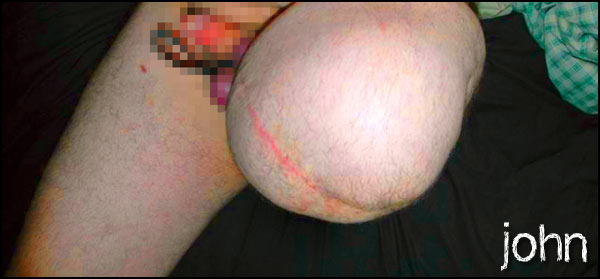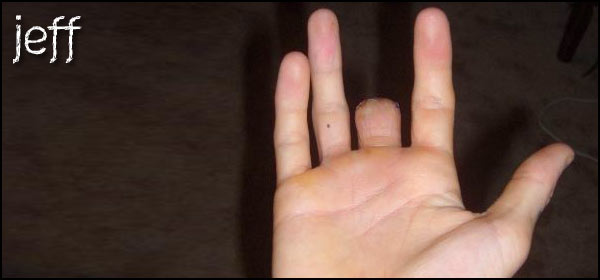|
Yesterday we talked to a few individuals who “needed” amputations for primarily physical reasons, so today I’d like to chat to two people who chose amputation for purely psychological reasons, each choosing to self-amputate one of their fingers at home, disguised as an “accident”. Both of them did this privately and secretly, for themselves, so the pictures in the article are not actually of them. BME: Tell me about yourselves? Douglas: I am a thirty year old male from northern Europe, and I live in a small community with me wife and son. Beth: I’m completely sane, and to all intents and purposes ‘normal’. I just happen to be driven to do things in a way that most people can’t understand, and I’m capable of doing things to myself that a lot of people are not. I believe I’m somewhat unusual as I’m female and I did this entirely alone and without any assistance or help from anyone. I have five digits on one hand, four and a small nub on the other, having removed most of my ring finger. BME: Why did you choose to amputate your finger? Beth: Because I wanted to, I could, and it made me happy. Douglas: A few reasons — one of the reasons is actually your fault Shannon! If it wasn’t for BME and the ModCon book, I probably wouldn’t have been thinking about it the years before I did it. BME has opened my eyes to various body modifications, and I have always been fascinated by people doing extreme things to their bodies. Amputation is as far as you can go if you ask me, and I wanted to see if I was able to do it myself. BME: Was it rewarding or worth it in terms of that way of thinking about it? Douglas: Yes, it was. I haven’t gotten pierced since the amputation, and I have some tattoos left to be done, but otherwise I feel complete in my body transformation. I used to be somebody else, but today I am me. BME: Do you feel that BME should do more to discourage people from cutting off fingers, or would this just make it even more appealing on that level? Douglas: If people want to cut off their limbs, they will do so even if BME discourages them from doing do so. What I think is more important is that BME should provide “safe” guides on how to DIY and that someone (not neccecary BME) should the person them to slow down and think about the consequences it will have for the rest of their lives. That goes for all modifications. BME: You said you have other reasons as well? Douglas: We have a friend of our family that is missing fingers from different accidents and wars. I can’t swear that it formed my interest, but from a psychological point of view, it probably did. The first time I came across DIY amputation was when I was twelve years old. My mom and I went to the movies and saw a film named “Black Rain”. It’s a film about an American cop going to Japan to deliver a prisoner, but something goes wrong and the prisoner escapes and blah blah blah. It’s not a very good movie, but the Japanese prisoner is a member of the Yakuza, and in the movie he cuts off his own finger in a traditional way. That had a huge impact on me. I remember thinking “WOW!! That is some heavy shit! Are people really capable of doing that!?” Yes, they are. BME: That’s funny — I remember that scene making a big impact on me as a kid as well. How did you do your amputation? Douglas: I got intoxicated with alcohol, put a rubber band on my pinky and injected some lidocain with adrenaline in it. Then I waited about thirty minutes or so, and then I took out a huge kitchen knife and ‘popped’ the joint in the finger with some heavy pressure. Beth: I had no desire to go through the knuckle joint — disarticulation. I wanted to go through in between knuckles. My need was very specific. I obtained injectable xylocaine, a syringe, a rubber band, a scalpel, butchers poultry shears, a paring knife, a belt, and a towel. I found out how to perform a digit nerve block from a nursing guide. After administering the xylocaine in the appropriate places I tied off tightly with a rubber band and placed my hand on a chopping board. Originally I intended to excise the tissue away from the bone first, leaving a longer flap on the underside. I figured this would make patching it up easier, having studied closure procedures on medical websites. Of course it didn’t occur to me how suspect that would have looked in the emergency room but that idea went out the window anyway once I began to cut. I started on the top side by pressing down with the scalpel as hard as I could. It cut easily, but I was surprised by the sudden bleeding — that may sound stupid, but I guess I panicked. I sat on the floor and placed the blade of the poultry shears into the cut I had started and squeezed as hard as I could. The nerve block was perfectly administered and I felt no pain whatsoever as I closed the blades. It didn’t require too much pressure to go through the bone — it just kind of went ‘clunk’. It took a couple of goes to cut through the flesh. My finger was still partially attached, so I returned to the chopping board and quickly sawed through the remaining piece of tendon. It was very tough. I had a brief look at my new hand, removed the rubber band, used the belt as a tourniquet and wrapped it in a towel before presenting myself at the emergency room.
BME: What story do you tell people about how it happened? Douglas: I used to tell people some bullshit lies, but it always ended with me not being able to follow up the questions. My friends knew beforehand that it was about to happen, and most people that know me “know” what really happened, but they can’t prove it. Nowadays I tell people that I was drunk in my kitchen, and that I really don’t feel comfortable speaking about it. I don’t lie, do I…? Beth: I say I had an accident boning out a joint of meat. I played the female hysteria card. That helped me avoid too much close questioning, and gave me an excuse for failing to bring the digit with me for re-attachment — far too icky and gross! Ha-ha! Plus of course the unhygienic manner in which I became detached from it made it less attractive an option. Only one doctor made an issue of re-attachment, and I made it quite clear to him that it wasn’t going to happen. The happiest moment was when the nurse took me to have an x-ray and as I laid my hand on the cold plate I was very aware that that finger was not making contact and was no longer there. It suddenly hit me — it was gone and I felt elated. I had surgery under general anaesthesia to repair the stump. BME: How was your aftercare and healing? One of you went through the bone, and the other went through the joint, so I assume it was different. Beth: Very, very painful. For the first few days it felt like I had hit it with a hammer but the pain didn’t dull — it was persistent. And very slow indeed. I took antibiotics and pain killers. After ten days I had the sutures removed and began massage and exercise. It took a long time for the swelling to go down. Douglas: Mine was very easy. I went to the hospital and the surgeon did an amazing job. They fixed all nerves and tendons, so I don’t have any phantom pain at all! The first few days I was on some heavy medication, and I got out of my job for a month or so. That made able to rest up properly. BME: Was there an aspect of guilt? I know in previous interviews readers have raised the concern that it’s “taking advantage” of the system to make the healthcare system pay for voluntary mods? Douglas: I have allways paid my taxes, and I would be happy to pay more, so no, I didn’t feel guilt at all. I see your point, but I don’t see it as stealing from other people by using a system I pay for. BME: What does it feel like now that it’s healed? Beth: I’m very aware of it; it feels different. I guess it’s slightly tight feeling when I make a fist, and it’s much more susceptible to cold than my complete fingers. I love how it looks, and how differently my other fingers move and behave in order to adapt to the loss. It’s very sensitive. I enjoy having it sucked and nibbled very much indeed. It’s one of the best choices I ever made. Douglas: It is very hard to describe, but the easy way out would be me saying that it feels normal. I don’t remember how it felt with the finger still attached to my body. My body reacts like if it had been like this since day one. I use what’s still left of the finger as I used my old finger. BME: That’s interesting — so there’s no “phantom fingertip”? It just ends mentally where it ends physically now? Douglas: That’s right. At first, my mind was set on still having the finger, so when I tried to “tab” the computer or itch my nose, or even biting my nails, I found out my body didn’t comply with my brain. Also, I dropped things all the time. It took about a year or so for the mind to be ok with it.
BME: Is there anything you’d do differently if you could do it over again? Douglas: There are four things I would have done differently:
Beth: Not that I can think of. I’m very satisfied. BME: Will you do more amputations? Douglas: I will never say never, but at the moment I don’t have any plans on it. Beth: I don’t think I could pull off another ‘accident’. BME: Finally, how did you choose the specific digit to remove? Douglas: I don’t know actually. I have always known it would be a finger or a toe, but finger seemed easier to do by yourself. Beth: It’s strange. I don’t remember what made me focus on that particular finger, or for how long I had wanted to do it. There are reasons which I not prepared to divulge which may have triggered me to begin with. Then I simply became obsessed, driven to remove it. I fantasised about it constantly. I would bend it down and pretend it had gone. I wouldn’t say I had a dislike for it, it just wasn’t ‘right’ and I wanted it gone. In my mind it was gone long before the actual act of removing it.
|
